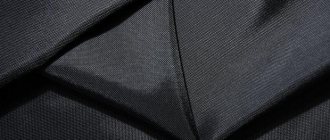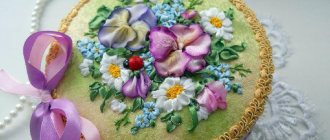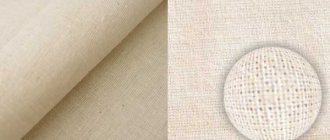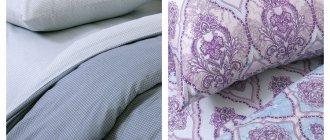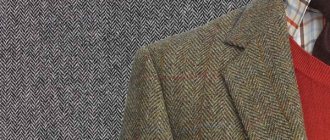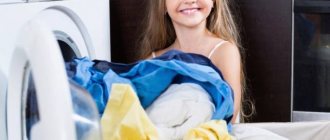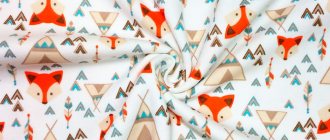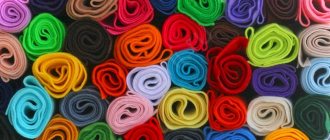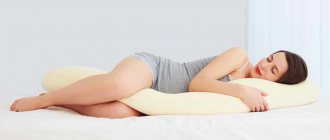General tips for choosing pillow fabric
To ensure that your favorite pillow lasts as long as possible, it is covered with a pillowcase. The choice of fabric directly depends on the purpose of the household item.
The most necessary tips:
- pillows used for sleeping are covered in covers that are soft and pleasant to the skin (cotton, linen, silk pillowcases);
- fabric for decorative pillows is used with a strong structure that is resistant to wear (teak, satin, jacquard, twill, percale, cambric).
For delicate and soft filling, choose thin fabric for pillows. Down products are an exception. Dense material should not allow fluff and feathers to pass through, remaining durable. It is cotton teak that has these characteristics.
Modern interior
To choose the right fabric for a pillowcase for a wool product, you need to take into account the breathability and thermal conductivity of the fabric. In this case, cotton will be the ideal material for a pillowcase.
Silk bedding can be covered with satin covers, and microfiber pillowcases made from natural fabrics.
Sofa cushions are designed for long-term use, so the durability of the material is taken into account. Upholstery fabrics in the form of fleece, faux suede, fur or velor can create comfort and ease in the elements used in the interior of the room.
Attention! Fabric for sofa cushions is chosen taking into account the combination of colors of furniture, curtains, paintings and floor coverings. The modern style of products decides a lot in the design of a home.
Variety of colors
Fabric characteristics
The type of thread weaving is the most important indicator of the type of material.
Note! The quality characteristics of fabrics differ depending on the composition of the thread and the strength of the fibers.
Differences:
- Teak, made from cotton or linen, is wear-resistant and durable. Teak pillowcases hold their shape well and have water-repellent properties.
- Smooth satin is a soft material that hardly wrinkles and adapts well to the desired body shape. Excellent ventilation properties allow the scalp to breathe during hot periods.
- Satin jacquard is distinguished by its beauty and sophistication. Elegant pillows look harmonious on the bed and on the sofa.
- Twill makes the interior item elastic and voluminous. The fabric is soft to the touch and quite strong and dense.
- Percale is one of the best linen fabrics. The soft and wear-resistant material can be easily painted in bright colors, delighting the eyes with multi-colored pillows.
- Batiste is made from the finest threads of cotton and is used for airy down pillows. The range of such products is used for infants and allergy sufferers, people with sensitive skin.
- Cotton is the most inexpensive of the non-allergenic fabrics. The material is easy to care for.
- Linen is ideal for use in hot weather. The surface of the fabric slightly cools the skin when in contact with the pillowcase.
- Silk remains soft at any time of the year. Pleasant to the touch like royal material, it requires appropriate care.
- Wool with a “dry heat” effect relieves ailments, relieves muscle, headache and toothache. Requires special care. The fabric is prone to shrinkage.
You may be interested in: Is it possible to make liquid skin yourself and how to use it?
Decorative pillow
Materials for decorative pillows
Pillowcases are made from different types of textiles: from natural to synthetic. At the same time, the top fabric for decorative pillows should be pleasant to the touch, strong, durable and wear-resistant.
Popular materials:
- furniture fabrics;
- atlas;
- silk;
- velvet, velor, plush;
- tapestry and jacquard fabrics;
- cotton, linen;
- brocade;
- fleece;
- artificial fur.
Decorative pillowcases are decorated with braid, cords, lace, embroidery, and accessories.
Design and types of decorative pillows
The main purpose of a pillow has always been considered to support the head during sleep. Classic rectangular or square pillows are the most common products on the market.
The appearance of products of a specific configuration is associated with a therapeutic effect in diseases of osteochondrosis, scoliosis and after injuries to the musculoskeletal system. Correcting the position of the head and body during sleep brings certain benefits to those suffering from various ailments. Such pads are usually called orthopedic.
Decorative interior elements in the form of pillows of various shapes have already gained popularity and are widely used to decorate not only children's rooms and living rooms. Animals, flowers, rhombuses and hexagons, berries and leaves - this is not a complete set of forms of modern products.
Interesting! The non-standard purpose of items made from filler in a case is used as a travel item, a car accessory, to help a nursing mother, for a pregnant woman to sleep, a medicinal roller filled with medicinal herbs, a garden option.
Products for lining under the back and relieving pain in the lower back, as well as for legs with arthritis and varicose veins, are more like soft rugs than pillows. They are made in the form of horseshoes, bolsters and thin mattresses with fillings.
Orthopedic sleep product
What is a pillow cover?
What is a pillow cover? As one of the components of a bedding set, it is not difficult to buy bed linen and any bedding now.
Externally, the napkin looks like a bag sewn up on all sides and stuffed with fillings. This is the base of the pillow, which helps support your head during sleep and rest. Fillings for pillows can be down or feathers, synthetic materials, foam rubber and much more.
Of course, the greater the density of the bedstead fabric, the higher its quality characteristics. Thick fabric linings allow the pillow to be suitable for use for a long time. In order for the napkin to serve longer while maintaining its functions, it is better if natural fabrics are used as the material for sewing the napkin.
The presence of natural fibers in the fabric for pillowcases will help the pillow acquire good air exchange; you can easily buy women's Ivanovo knitwear at retail and bedding made from natural fabrics on the Internet.
Air exchange will prevent moisture from accumulating in the pillow. The absence of moisture will eliminate the processes of rotting and the appearance of insects in the pillows, such as linen mites.
Deciding on the size of the pillow
Our grandmothers used large 70x70 duck down pillows that were arranged in pyramid shapes on their beds with muslin throws. Embossed patterned curtains to match the pattern on the pillowcases, marked with the same hand-made patterns.
The choice of a future wife was very often determined by her perseverance in needlework and her skill in inventing patterns in embroidery and embossing three-dimensional patterns in the cutwork style. Modern factory fabrics deprive the value of handmade work, surpassing the speed and quality of product manufacturing.
The most popular sizes of pillows for the bedroom are considered to be square with dimensions of 50×50 cm and rectangular 50×70 cm. The Euro standard of bed linen, brought to the domestic market, is dictated by the purchase of beds and furniture made to the sizes of European manufacturers. This factor significantly influences the choice of pillow size for sleeping.
Decorative items for the living room and nursery have non-standard shapes and arbitrary sizes. GOST and any standard have left the consumer market, dictating fashion trends towards the absence of a stamp and the manifestation of individuality in choice.
You might be interested in what satin is: description of fabric for curtains
Attention! The shape of an oval or circle can have any size. And armchairs with cushions or armchairs with balls are simply off the charts with their original personality.
European standard
Why do you need a pillow protector?
Why do you need a pillow protector? The main function of the pillowcase is to maintain the shape of the pillow. The pillowcase allows the filling not to come out, and a pillow with a high-quality pillowcase retains its softness for a long time and does not turn into a hard rag.
The napkin also performs a hygienic function, it can be washed, of course, not as often as bed linen, but after washing, a napkin made from high-quality materials will retain its properties and will serve for a long time, such napkins can be bleached in the same way as bleaching bed linen at home, We already know about the methods.
A huge amount of dirt, dust, sweat, and insects accumulate in the pillows. Therefore, it is better to choose diapers that will allow you to periodically wash the product. You can take the pillows to the dry cleaner, and in the summer it is good to dry the pillows, especially those with down filling, in the sun.
How to stuff a decorative pillow with your own hands
The filling of a pillow depends on who will sleep on it. Down, feather filling, synthetic wool, bird feathers, padding polyester or holofiber are commonly used fillers.
Non-standard components may include medicinal herbal infusions, hop cones, and buckwheat husks. The shelf life of this filler is short-lived and equals 1 year. The therapeutic effect gradually decreases and using such a pillow will not be beneficial.
The use of textile fiber or animal wool is possible with constant beating of the contents, because it tends to clump.
Fillers with therapeutic effect
Pillow cushions: manufacturing diagram
Fabric for napkins - what is it called? It all depends on the required quality and composition. You can choose from popular ones:
- batiste;
- percale;
- satin;
- Jacquard, named after its inventor Joseph Marie Jacquard.
A pattern for sewing a pillowcase or bedspread is usually not used if it is square in shape. To make several products of the same size, the cut blank is placed on the next section of fabric and the future part is cut out from it. The pattern will be the form itself made from the material.
The principle of preparing a pattern is to apply two squares the size of the pillow onto the fabric with a piece of chalk or soap. There is no distance between them; they merge into one rectangle. For the inner flap of the pillowcase without using fasteners and zippers, add another third of the square in width. This part of the product will hide the end of the pillow.
Important! For side seams it is necessary to leave 1-2 cm, this factor depends on the structure and thickness of the fabric.
The sequence consists of processing the end edges of the pillowcase, one of which will remain outside the product. Then the products are folded according to the size of the pillow into a square shape and the connected parts of the pillowcase are processed. The pillowcase turned inside out is ready.
Pillowcase pattern
If a zipper is sewn from the end part, then there is no need to leave an allowance for the lapel. Ideal two squares with a sewn-in zipper are processed on three sides of the perimeter.
The division of a pillowcase into two separate parts occurs only if fabrics of different colors or textures are used for sewing the sides. Sometimes a decorative item for a sofa has a front part trimmed with embroidery or other decorative elements.
You might be interested in Description of jacquard fabric, what it consists of and where it is used
Scented pillowcase
Consumables and tools
What will be useful:
- A piece of fabric or a combination of several materials in one product.
- Sewing machine (sometimes decorative items are made by hand).
- Sewing threads of matching color (you can use thin fishing line, office thread for stitching documents).
- Tape divided into centimeters.
- Chalk or thin dried piece of soap, fabric marker.
- Cutter's scissors.
- Safety pins or clips to hold pieces of fabric in position.
- Zipper (if needed).
Sewing tools
Sewing technology
The most important thing in sewing a bedspread or pillowcase is the correct calculation of the required fabric. If in doubt, you can first calculate the consumption on paper and draw the shape of the future product in a reduced size.
Experienced cutters place templates from the edge of the fabric so that as little fabric as possible is used for trimming. The width of industrially produced fabric has sizes of 80, 120 and 150 cm. Less common are 220 and 145 cm.
When using cotton materials, take into account the shrinkage of the fabric after washing, leaving allowances around the perimeter of the product.
Inexperienced seamstresses are recommended to sew their first items from leftover fabric or some items not used for their intended purpose. The fabric for the cushions on the sofa can be selected from paita, which has become out of fashion or a damaged bedspread, or an old favorite curtain. Applying a design or embroidery before making a product. Combining red and turquoise colors, this activity is called anti-stress. Doing decorative finishing by hand is beneficial for pregnant women.
Combined sofa cushions
Sofa cushions - photo gallery
Read: Looking for delicious, inexpensive sushi? It's all about "Makarollich".
Let's discuss this article together:
Click to cancel reply.
Care
The accumulation of dirt and grease in pillows can gradually lead to allergic reactions. Linen mites, fungi and pathogenic bacteria that cause attacks of bronchial asthma, rashes on the face in the form of acne, must be destroyed by periodic processing of products.
Washing pillows is recommended 2-3 times a year. Change the nappers at least once a year for a new one. Keeping the bedstead clean can increase its service life and reduce the risk of disease to a minimum.
Product care
Schoolchildren can sew their own napkins and pillowcases. There are no special secrets to cutting and sewing. You can hone your skills at home, starting with simple pillowcases and moving on to making decorative pillows for the living room.
Variety of species
The creative impulse should never be put off until free time appears. You need to start when the fire is burning in your eyes, and your hands want to do things. Any room can be transformed with decorative pillows. Also, it is worth noting that pillows are intended not only for a comfortable sleep, but also for medical reasons.
What are napkins made of?
What are napkins made of? Nedniks, as we have already said, are best made from fabrics that contain natural fibers; in addition, the fabric must be dense, so the following fabrics are most often used for sewing napkins:
- teak;
- cotton;
- satin;
- batiste;
- percale;
- polycotton;
- calico
The composition of teak is cotton or flax fibers, which are characterized by high density. The use of teak when sewing pillowcases allows you to increase the service life of the pillow, because the high density of the material prevents the filler from thinning.
In the production of teak, cotton or linen fibers are tightly woven using a plain or twill method. In order to reduce costs, some manufacturers add synthetic fibers to teak; the addition of such fibers makes the fabric rougher and rustier. In order to increase the density of teak, manufacturers treat the surface of the fabric with wax.
For sewing naperniki, fabric such as calico is often used; in Ivanovo, textiles in catalogs with retail prices always include naperniki.
The composition of calico is cotton fibers. Calico has a high level of hygroscopicity and allows air to pass through well. Products made from calico tolerate numerous washes well. In addition, this material has a very affordable price.
Not very often, but it still happens that manufacturers use polycotton for sewing napkins. The composition of this material includes both cotton and synthetic fibers.
In terms of its properties, this material can easily compete with calico. It is not very demanding in care, we have already looked at how to fold bed linen correctly and not iron it, this storage scheme also works with bed sheets.
It happens that more expensive materials, such as satin or percale, are used to sew napkins. It is better to use such materials together with an additional cover. This fabric can also be used for expensive fillers, such as down.
In order for the pillow to serve as long as possible, it is important to choose not only the material for the pillowcase, but also to choose the correct technology for sewing it. There are two ways. First: with the help of a shock-absorbing seam, such a seam allows you to avoid using edging in the production of bedsteads. Second method: using edging. The edging prevents the filler from coming out through the seam.
